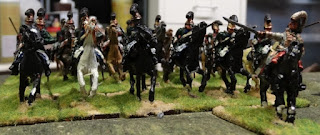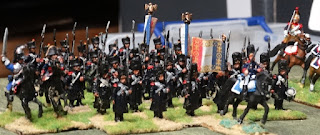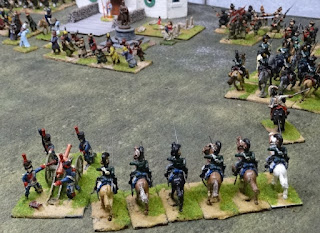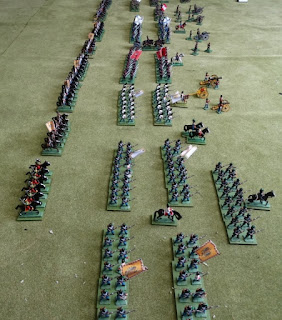Went over to Bob’s to play our first game in what seemed like an age, a bereavement in my family followed by holidays and hot weather turning his garage into a stage set for Bridge on the River Kwai (kept expecting Alec Guinness to emerge at any moment) meant that the months had rolled by.
Bob had been busy on his French and
Russian Napoleonic figures and so we decided that they deserved an outing. As Bob pointed out if he put them all out
they would stand shoulder to shoulder from one edge of the table to the other
so we decided to each have reserves that would come onto the table in move 3.
Bob commanded the French and I had
the Russians. Overall Bob’s Brigade
commanders were much better than mine with two having command scores of 10 and
another with a score of 9. Oddly in fact
this proved to be a disadvantage as you will see and left us puzzling about
whether we had got the rules right.
The French forces including
reserves:
3
brigades each of3 infantry regiments (3 x Old Guard)
4
regiments of Cuirassiers
2 units
of Carabineers
4
regiments of Chasseurs a cheval
5
regiments of Line lancers
2 x
horse artillery
2 x foot
artillery
3 regiments of Line lancers on the
left flank with a horse battery; an infantry brigade in the middle supported by
a heavy cavalry heavy cavalry with Chasseurs a cheval on his right
The Russians including reserves:
3
brigades of 3 infantry regiments
Peasants
5 x
Uhlans (2 Guard)
5 x
Dragoons (2x Guard)
3 x Line
lancers
2 x
horse artillery
2 x foot
artillery
1 x unit
of Cossacks
The Russians had less cavalry to
start with but had two brigades of infantry, a regiment of Cuirassiers and a
brigade of lancers, 2 field batteries and 2 horse artillery batteries. They were given the additional moral support
of Monks and a superb Russian Church built by Jack which inspired the local
peasants to heroic levels (and frankly silly success).
The French had the initiative and
immediately Bob threw forward his lancers on the infantry brigade to the front
hoping to catch them out of formation.
Unfortunately, the charge fell short but we felt that the Russians would
try to make square given the proximity of the lancers. Each regiment in the brigade tried to form
square, one managed it one didn’t and the other managed a blunder test and fled
the table! Not a good start.
The centre units all advanced slowly
but on the right the Chasseurs pushed forward, but not enough to make contact
with their Russian opposite numbers.
The unfortunate lancers not only
found them short of my infantry but in close range of my artillery who together
which a ragged volley from the disordered infantry forced them to halt and
become disordered.
On my right I charged the French
Chasseurs with my lancers pushing them back and destroying them in the follow
up.
In the centre my Cuirassiers
advanced forcing the infantry into squares for safety.
The next move saw Bob bring on his
reserves, more heavy cavalry; the Guards; another brigade of infantry; line
lancers together with a field artillery battery.
And here’s where the problems started with the French high command levels, only needing a ten. Bob started
to get three moves on an almost consistent basis. We were playing 50% movement rates which left
units just short of contact with the Russians but at close range for
artillery and infantry fire but unable to fire.
 |
| Lovely resin Monk from V&V Miniatures |
The French infantry formed their lines and with a command factor of 10 swept across the table with three moves
charging the Peasants and my Russian Guard infantry.
The Peasants again worked wonders
scoring 2 sixes on the charging French infantry, neither of which was saved the
Guard also scored but they were saved. The French hit home. At this point we weren’t too sure what the
Peasants should be given by way of hand to hand dice. We settled on 4 dice given the superhuman
guidance they were getting from the Priests and their desire to save the church
from the hands of the French. This
resulted in their opponents being thrown back.
We think we over egged the Peasants as this seemed an unlikely
result. Whilst the French unit facing
the Guard although losing passed their Break Test with flying colours and hung on
in.
In the centre my Cuirassiers again
threw themselves forward charging the enemy lancers only again to win the
engagement and lose the melee and flee following a Break Test.
An attempt by the French to rally
their lancers on the right proved successful but before they could take
advantage more Russian artillery fire and a volley from the infantry who had
now managed to form a square was enough to see them destroyed together with the
gallant general who had risked all to get them reorganised.
Good through this seemed at the time
it merely cleared the way for a brigade of French infantry to advance on the
Russians.
Their supporting Cuirassiers decided
not to move at all which didn’t help!
During my turn the Russian Guns
opened up on the Guard brigade, and although they only managed one hit, it was
enough to require a Break Test. The
Guards failed this getting a ‘4’ after deductions causing the entire Brigade
square to flee the field.
Again the high command score sent
infantry forward at 3 moves blocking their own guns leaving them just short of
my Russian infantry on the right and their supporting field artillery. The result saw them taking a hit and fall
back as part of their Break Test.
The French infantry
and disordered cavalry across the table prevented the French from taking
advantage of their remaining cavalry superiority.
At this point we called a halt to a
game which we had played over two separate days a week apart. Whilst the Russians had seen off the attack,
the French were still serious contenders if we wanted to allow a bit of
reorganisation. The Russians had
infantry superiority but the numbers of French cavalry presented a threat to
manoeuvre anywhere on the table and there wasn’t enough Russian cavalry to see
off all the threats. The problem for the
French was the high command levels prevented any real manoeuvring unless they
were moving from flank to flank.
Otherwise, they were going straight forwards and falling short bringing
them under both musket and artillery fire and unable to respond. The Russians lower command levels often only
resulting in 1 or no moves oddly worked to their advantage.
All the Russians were from Lancashire
Games except the Cossacks from Irregular Miniatures; the Peasants from Perry’s;
most of the Priest from Old Gory and a beautiful resin figure of priest from
V&V Miniatures.
The
majority of the French cavalry and guns are from Lancashire Games with a unit
of plastic Carabineers and Cuirassiers from Perry’s. The Infantry is a mixture of Warlord Games -
Outpost Miniatures (Old Guard in Bearskins by Perry) Generals on both sides
from a variety of sources the Church was scratch built by Jack Alexander





























































